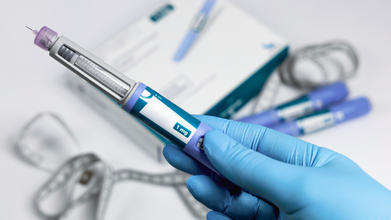- Health Conditions A-Z
- Health & Wellness
- Nutrition
- Fitness
- Health News
- Ayurveda
- Videos
- Medicine A-Z
- Parenting
This Harmless Habit Can Trigger Tinnitus-How To Safely Clean Your Ears

Credit: Canva
Many people instinctively reach for a cotton swab, commonly known as an earbud, to clean their ears, believing it to be the best way to remove earwax. However, what seems like a harmless routine can actually endanger hearing health. Improper ear-cleaning practices, especially the use of cotton swabs, can contribute to tinnitus—a persistent ringing, buzzing, or hissing in the ears that can be both distressing and disruptive.
Hidden Dangers Of Cotton Swabs
Many individuals assume that cotton swabs effectively clean the ears, but they often do more harm than good. Here are several ways in which they can trigger tinnitus.
Eardrum Damage
The eardrum is extremely delicate, and even slight pressure from a cotton swab can potentially perforate it. This can lead to pain, hearing loss, and in some cases, tinnitus. A perforated eardrum requires time to heal and may necessitate medical intervention.
Ear Canal Trauma
The skin lining the ear canal is highly sensitive. Using cotton swabs can scratch or inflame the ear canal, leading to irritation and swelling. This inflammation can impact hearing and contribute to tinnitus.
Impacted Earwax
Ironically, instead of removing wax, cotton swabs often push it deeper into the ear canal, where it can become impacted. A wax impaction can exert pressure on the eardrum, diminishing sound clarity and triggering tinnitus symptoms. This can also cause a sensation of fullness in the ear, dizziness, and temporary hearing loss.
Auditory Ossicle Disruption
The auditory ossicles, tiny bones in the middle ear, play a crucial role in sound transmission. Excessive pressure from a cotton swab can disrupt their function. If these delicate bones are affected, it can lead to persistent tinnitus and other hearing disturbances.
How To Safely Clean Your Ear?
Fortunately, maintaining ear hygiene does not have to involve risky practices. The following are medically approved techniques to keep ears clean without causing harm.- Gentle Outer Ear Cleaning: The safest way to clean your ears is to focus only on the outer part. Using a soft, damp washcloth with warm water helps remove dirt and wax from the outer ear.
- Over-the-Counter Drops: Those with excessive earwax buildup may benefit from cerumenolytic (wax-softening) drops. These drops help loosen stubborn wax, allowing it to naturally migrate out of the ear.
- Gentle Irrigation: For individuals without eardrum perforations, a soft rubber bulb syringe filled with body-temperature water can help flush out loosened wax. Irrigation should be done cautiously to avoid excessive pressure, which could lead to dizziness or eardrum injury.
When To Seek Medical Help
Some situations necessitate professional ear cleaning rather than at-home methods. Health experts recommend consulting a doctor if you experience:
- Persistent ear pain or discomfort
- Ear drainage or foul-smelling discharge
- Sudden hearing loss or changes in hearing
- A history of ear surgery or eardrum perforation
- Frequent wax buildup affecting hearing
Mystery Disease Adenovirus: New Virus Said To Be Stronger Than Covid And Flu — All You Need To Know

Credits: Canva
Adenovirus: A newly emerging “untreatable” mystery virus that is being described as stronger than Covid is now spreading across several parts of the world, with experts warning that even common disinfectants may not be effective against it. Known as adenovirus, the infection causes symptoms similar to a severe bout of flu, such as shortness of breath, a runny nose, and a sore throat. What sets it apart, however, is the limited treatment available.
In most cases, people who contract the virus have no option but to manage symptoms and allow the illness to pass on its own. The good news is that adenovirus infections are usually mild. That said, much like Covid or seasonal flu, the risk rises for people with weakened immune systems, who may experience more serious complications, according to a report by The Mirror.
Jefferson Health’s medical director of infection prevention and control, Eric Sachinwalla, has cautioned that unlike more familiar viral infections, there is very little doctors can do to actively treat adenovirus.
What Is Adenovirus?
Adenoviruses belong to a broad family of common viruses that can affect multiple parts of the body, including the airways and lungs, eyes, digestive system, urinary tract, and even the nervous system. They are a frequent cause of fever, cough, sore throat, diarrhoea, and conjunctivitis. Most infections tend to be mild and clear up on their own within a few days. However, health experts are now noting a rapid rise in cases, with the virus spreading quickly and leaving large numbers of people unwell.
The virus is particularly contagious because it is tougher than many others. Routine cleaning with soap and water or standard disinfectants may not be enough to eliminate it, allowing it to survive longer in the environment. This is why outbreaks are often seen in places such as day-care centres and military barracks, where close contact is common. Adenovirus spreads through respiratory droplets, can be passed through stool, and can linger on contaminated surfaces for extended periods, as per Mirror.
Adenovirus Symptoms
Symptoms of adenovirus infection can vary widely. Common signs include shortness of breath, a runny nose, and a sore throat. Some people may also develop diarrhoea or pink eye. The wide range of symptoms is partly due to the fact that there are more than 60 known strains of the virus.
Adenovirus: How Is Adenovirus Different From Covid And Flu?
Adenoviruses, like coronaviruses, spread from person to person and can trigger similar respiratory symptoms. However, they belong to entirely different virus families and behave differently. One key difference is resistance. Coronaviruses are more easily destroyed by disinfectants, while adenoviruses are harder to kill, which allows them to spread more easily than Covid or flu.
For otherwise healthy individuals who feel unwell but do not have severe symptoms such as high fever or breathing difficulty, recovery usually happens at home with basic supportive care. Medical attention is more important for people with weakened immunity, parents of very young infants, or those with existing conditions like heart or lung disease. If symptoms appear, experts advise against walking straight into a clinic. Calling ahead is safer, as doctors may recommend a telehealth consultation if the illness seems highly contagious.
Adenovirus: Is Adenovirus Untreatable?
Most adenovirus infections are mild and resolve without medical treatment. However, if symptoms linger or worsen, there is often little doctors can do beyond monitoring and symptom relief, as the virus largely needs to run its course. Following basic hygiene measures, such as washing hands regularly and cleaning frequently touched surfaces, remains one of the most effective ways to reduce the risk of infection.
What Is The Experimental HIV Drug Charlie Sheen Says Suppressed The Virus In His Body?

Credits: AP
Though Charlie Sheen’s HIV has been described as “completely manageable,” the actor recently shared that he once came across a treatment he believed worked far better than existing options, but it never reached the public. Speaking on the *Howie Mandel Does Stuff* podcast, the 60-year-old actor reflected on an experimental drug he used years ago and explained why it ultimately disappeared from view. “There was one that was really good that I was hoping would come to market one day, and it never did,” said Sheen, who publicly disclosed his HIV diagnosis in 2015. This has raised a key question: which experimental drug is Charlie Sheen referring to?
What Is HIV?
Human immunodeficiency virus, or HIV, is a virus that attacks the immune system. If left untreated, it can progress to acquired immunodeficiency syndrome, or AIDS, which represents the most advanced stage of infection. HIV primarily targets white blood cells, weakening the body’s natural defences. The virus spreads through unprotected sexual contact, sharing needles for drug use, exposure to infected blood, and from parent to child during pregnancy, delivery, or breastfeeding.
What Does HIV Do To A Person?
HIV infects CD4 cells, also known as helper T cells, which play a central role in immune response. As the virus destroys these cells, the white blood cell count drops, leaving the body vulnerable to infections it would normally fight off with ease.
Early on, HIV can cause flu-like symptoms. After that, it may remain hidden in the body for years without obvious signs, while continuing to damage the immune system. When CD4 levels fall very low, or when certain serious infections develop, HIV is considered to have progressed to AIDS.
At this stage, symptoms may include rapid weight loss, severe fatigue, sores in the mouth or genitals, recurring fevers, night sweats, and changes in skin colour.
Charlie Sheen Claims An Experimental Drug That Works Better For HIV
During the podcast conversation, Sheen named the drug he believes made a major difference. “That was a thing called PRO 140,” he said. He described it as a monoclonal antibody that produced faster and more consistent results, with fewer side effects than standard treatments. When asked why it never became widely available, Sheen suggested it may have posed a threat to existing therapies. “It works, better than what they have,” he said, adding that the company behind it ran into serious trouble. Mandel responded that someone should investigate further, a point Sheen agreed with.
What Is The Experimental Drug Charlie Sheen Is Talking About?
PRO 140 is a humanised monoclonal antibody designed to block CCR5, a receptor HIV commonly uses to enter human cells and replicate. Around 70 percent of people living with HIV in the United States, and as many as 90 percent of newly diagnosed patients, carry CCR5-tropic strains of the virus.
Earlier studies found that a single intravenous dose of PRO 140 sharply reduced HIV levels, while weekly injections under the skin lowered viral load much more effectively than a placebo. Research also suggested that the drug did not interfere with normal immune functions linked to CCR5.
According to Aidsmap, PRO 140 was generally considered safe and well tolerated. Although more than 90 percent of participants in extended studies reported side effects, there were no serious adverse reactions linked directly to the drug, and no one had to stop treatment because of it. The reported side effects were limited to injection-site reactions, which were usually mild to moderate.
Sheen has repeatedly spoken about his experience with the drug, maintaining that it delivered steadier results and caused fewer side effects than conventional HIV treatments.
These Are The 7 Common Mistakes People Make After Stopping Their Weight Loss Jabs

Credits: iStock
Weight loss drugs are now common, but so are its side effects, especially when you stop taking it. There are numerous reports of how these popular weight loss jabs like Ozempic, Mounjaro, and Wegovy, once stopped, had changed people's cravings, food choices, and some have reported that weight too have come back.
However, Dr Donald Grant, GP and senior clinical advisor at The Independent Pharmacy tells Metro that it is quite common for people to regain some of the weight once they stop the medication. As of now, 1.5 million people in the UK are using these jabs, and reports say that some may end up heavier than when they started. Why does this happen?
Also Read: Mystery Disease Adenovirus: New Virus Said To Be Stronger Than Covid And Flu — All You Need To Know
Dr Grant says that there are various factors including metabolism to appetite, however, there are also 7 common mistakes that people do once they stop taking their weight loss jabs, which must be avoided.
Abruptly Stopping Weight Loss Jabs
Going cold turkey could increase the weight, warns Dr Grant. Since these medicines work by suppressing the appetite, stopping the medications suddenly could lead to poor eating habits and potential weight gains. The best way? Talk to your GP before making a decision to come off the weight loss drugs. A medical professional could guide you on how to leave the medication, while making amends to your lifestyle habits.
Not Changing Your Lifestyle
A recent study by scientists at the Oxford University, of the 6,000 people who use GLP-1 drugs, most will gain back their weight within the 10 months of stopping the medicine. This happens because once the medicines are stop, people do not replace the treatment with healthy habits. this could lead to weight gain.
Doctors suggest that even 30 minute of daily exercise could make the difference and burn the extra calories.
Discontinuing Early
If you stop taking your GLP-1 medications early, it won't work. Dr Grant points out that this is one of the most common mistakes people make. "These drugs are designed to be used long-term, but not doing so gives the body little time to adapt to the treatment."
Also Read: Flu Cases In US Reach 5 Million Mark, Reveals CDC Data
Sticking To The Same Diet
If you continue eating unhealthy while you are on Ozempic, Mounjaro or Wegovy, then you will regain the weight once you stop. Dr Grant says, "It is important for people to draw up a dietary plan, including structured meal times to avoid overeating. I also recommend a well-balanced diet including a variety of high-protein, fibre-rich and healthy fat food."
Not Monitoring Weight
"While it’s important not to create an unhealthy relationship with weight management, tracking weight closely once ending any treatments can help people adjust their routine to avoid losing progress," says Dr Grant.
Regular monitoring weight can ensure that you can get back on track before you lose too much progress after you stop taking your weight loss drugs.
Emotional Eating
If you have an emotional relationship with your food, then weight gain is possible. This is because emotional eating could lead to hormonal imbalance, stress, poor sleep, and unresolved trauma. While the jab can reduce weight, once stopped, if emotional eating is continued, you can easily gain it back. The best way to deal with this is by addressing the issue, speaking to an expert or a mental health specialist.
Not Eating Protein
Even after you stop your weight loss drugs, it is important that you continue eating enough protein. Protein helps in muscle building. Not eating enough protein, could lead to weight gain, by muscle loss and lower metabolism.
© 2024 Bennett, Coleman & Company Limited

